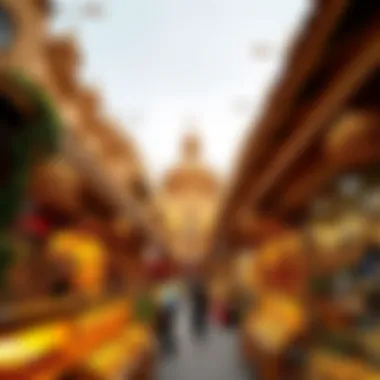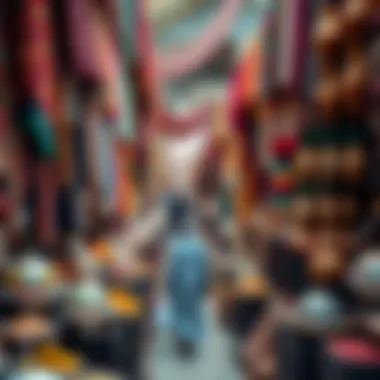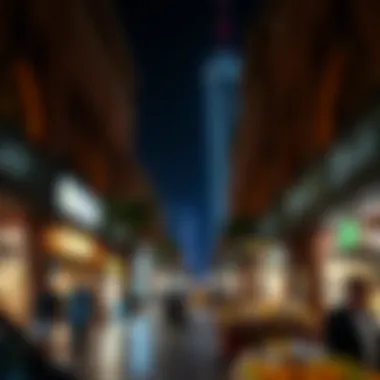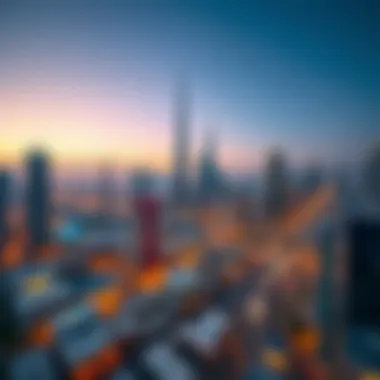From Gold Souk to Meena Bazaar: Dubai's Cultural Shift


Intro
In the heart of Dubai's bustling urban landscape lie two iconic marketplaces that reflect the city's rich cultural heritage and its ever-changing socioeconomic environment. The transition from the traditional Gold Souk to the lively Meena Bazaar encapsulates a story of evolution, adaptation, and resilience. Both spaces not only showcase the vibrancy of Dubai but also embody the aspirations and challenges faced by its diverse populace. Understanding this shift is essential for anyone interested in Dubai's development, not just as a tourist destination but as a hub for investment and economic growth.
The Gold Souk, with its labyrinth of shops gleaming with exquisite gold jewelry, has long been a symbol of wealth and trade. It offered visitors a glimpse into a time when Dubai's economy was intricately linked to its trading roots, with traders from far and wide flocking to this market. Meanwhile, Meena Bazaar represents a more modern approach to commerce, with a broader range of goods and a dynamic shopping experience that caters to a wider audience.
This article will delve into the historical significance of both marketplaces and explore how their evolution has mirrored broader trends in Dubai's real estate and economic landscape. By examining current market trends and providing insights into investment strategies, readers will gain a nuanced understanding of the implications these shifts hold for locals and visitors alike.
Let's embark on this journey that weaves through time, culture, and commerce as we explore the fascinating transition from the Gold Souk to Meena Bazaar.
Foreword to Dubai's Marketplaces
Understanding the vibrant landscape of Dubai's marketplaces is crucial for anyone keen to grasp the city's cultural and economic dynamics. These markets, rich in history and cultural significance, have been the heart and soul of commerce in Dubai. From ancient barter systems to contemporary retailing, marketplaces reflect the evolution of consumer behavior and societal values.
In this article, we dig into two iconic marketplaces: the Gold Souk and Meena Bazaar. The significance of these markets extends beyond mere shopping. They serve as microcosms of Dubai’s transformation, showcasing how traditions have been preserved even as the city modernizes.
Understanding the Role of Traditional Markets
Traditional markets in Dubai, such as the Gold Souk, are not just places to exchange goods; they embody the very essence of the city’s social fabric. These markets offer a sense of connection, bringing together diverse communities, each with its own stories and histories.
Visitors often find themselves immersed in a sensory overload: the glinting of gold, the vibrant colors of spices, and the aromatic wafts of street food. Traditional markets foster a unique shopping experience that is hard to replicate in modern retail outlets. The interplay between buyers and sellers promotes a personalized approach to retail, something that mass-produced environments lack.
Moreover, these markets contribute significantly to Dubai's economy. By attracting both local and international tourists, they generate substantial revenue. A visit to a traditional market can turn into a veritable treasure hunt, with each corner presenting new discoveries. By preserving these marketplaces, Dubai upholds its cultural identity while simultaneously boosting its economic viability.
Overview of Dubai’s Economic Evolution
Dubai's journey from a small trading port to a global commercial hub is fascinating. The discovery of oil in the late 20th century served as a catalyst for rapid development. However, it was the reliance on traditional trade routes that laid the initial groundwork for today’s economic landscape.
Dubai has successfully diversified its economy, moving from oil dependency toward sectors such as tourism, finance, and real estate—creating a robust financial ecosystem.
This evolution has resonated through its marketplaces. As Dubai grew more affluent, the nature of commerce began to shift. While gold and spices remained staples in markets like the Gold Souk, the need for diverse offerings spearheaded the rise of Meena Bazaar, which caters to modern consumer preferences. Today’s shopping experience reflects this blend of tradition and modernity, appealing to both residents and the ever-growing expatriate population.
In summary, examining the marketplaces of Dubai provides insights not only into the city’s economic evolution but also into its cultural resilience. This narrative paves the way for understanding how the Gold Souk’s heritage and Meena Bazaar’s innovation reflect broader shifts in market dynamics and consumer behavior.
"Dubai’s marketplaces serve as crucial landmarks that portray the ongoing balance between retaining tradition and embracing innovation."
Through this exploration of marketplaces, we set the stage for delving deeper into the specific nuances of the Gold Souk and Meena Bazaar, capturing the essence of Dubai's vibrant commercial life.
The Gold Souk: A Jewel of Tradition
The Gold Souk represents a vital element of Dubai's identity, combining historical significance and economic vitality. As we explore this marketplace, it's important to appreciate how it serves not just as a place of commerce but also as a cultural touchstone for both locals and visitors alike. The Gold Souk's opulent displays and intricate designs tell a story of a community that takes immense pride in craftsmanship and tradition, making it an essential part of Dubai's rich tapestry.
Historical Context and Development
The roots of the Gold Souk can be traced back several decades, a monument to the rapid transformation of Dubai from a small trading port into a global economic powerhouse. Initially, gold trading in the region was a modest affair, often conducted in informal settings. However, as trade routes flourished, the Gold Souk began to take shape, evolving into a formal marketplace.
In the 1940s and 1950s, the influx of pearls and precious metals from the Arabian Gulf catalyzed growth. By the 1970s, the market had established itself, boasting hundreds of shops lined with glittering gold pieces. Today, it stands as one of the largest gold markets in the world, not just in terms of scale but also in terms of varieties offered, including everything from traditional designs to modern interpretations.
Cultural Significance of Gold Trading


Gold trading is not merely a commercial activity in Dubai; it is a deeply ingrained cultural practice. The act of buying gold extends beyond economic transactions; it symbolizes wealth, status, and love. For instance, it's common for families to purchase gold jewelry for weddings or auspicious occasions, making it an integral part of local customs.
Moreover, the Gold Souk plays an essential role in fostering relationships. Local and expatriate communities gather at this vibrant marketplace, creating a blend of cultures. Through this interaction, traditions are shared and celebrated, reinforcing the souk's status as a cultural hub.
Architectural Features and Layout
Architecturally, the Gold Souk presents a blend of traditional Arabian design and modern functionality. The layout of narrow alleys and bustling pathways captivates visitors. High ceilings adorned with intricate carvings allow light to cascade down onto gold displays, creating an enchanting atmosphere.
Many shops feature elaborate showcases, and some even boast custom design services. The shops vary in size, each presenting unique collections, reflecting the diversity of tastes among customers. This architectural vision seamlessly combines commerce with artistry, pulling on the strings of both functionality and aesthetic appeal.
Economic Impact on Local Business
The Gold Souk is not only a tourist magnet, it's also the lifeblood for local traders. The turnover of gold, especially during festive seasons like Eid or weddings, contributes significantly to the economic fabric of Dubai. Merchants in the souk depend on foot traffic, and the ambiance created through both longstanding tradition and new business innovations keeps the economic wheel turning.
The competitive pricing models, coupled with regional gold rates, have made shopping here attractive not only for residents but also for international visitors. The ripple effect of this economic activity spills into neighboring businesses, including jewelry designers, local craftsmen, and even real estate developments, making the souk a cornerstone of Dubai's marketplace and a significant contributor to its robust economy.
"The Gold Souk is more than just a market; it's a living museum of tradition where histories intertwine with everyday life, showcasing the wealth of cultures that thrive in Dubai."
In summary, the Gold Souk is much more than just a bustling marketplace of gold. It is a homage to the artisanal craftsmanship of the region, a critical economic driver, and a vibrant cultural nexus that reflects the heart of Dubai's communal identity.
Transitioning to Meena Bazaar: A New Era
The transformation from the Gold Souk to the Meena Bazaar embodies a pivotal shift in Dubai's marketplace landscape. This transition is not merely about a change in physical space; it signifies a broader evolution of consumer values and economic dynamics in the region. As globalization continues to influence local traditions, Meena Bazaar emerges as a contemporary answer to the needs and desires of a diverse clientele. The importance of this topic lies in understanding how Meena Bazaar is not just a market in itself, but a cultural melting pot, redefining social interactions and commerce in Dubai.
The Shift in Consumer Preferences
In recent years, there has been a notable shift in consumer preferences within Dubai. Many customers today seek a more diverse shopping experience than what the traditional Gold Souk could provide. While the Gold Souk was once the go-to destination for gold and jewelry, today's buyers often want a more holistic shopping environment. They look for convenience, variety, and a space that also speaks to their social and cultural identities.
Key Factors Driving this Shift:
- Global Exposure: As the city attracts a growing number of expatriates and tourists, their varied preferences shape the marketplace. People from different backgrounds contribute to a demand for something beyond traditional gold items.
- Lifestyle Changes: The modern consumer is looking for shopping experiences that also include dining, entertainment, and cultural interactions. This evolution reflects a lifestyle that values not just consumption, but also social engagement.
- Accessibility: Meena Bazaar is designed with accessibility in mind, making it easy for families and larger groups to navigate and enjoy. This contrasted sharply with the tighter, older pathways of Gold Souk.
"The consumer today wants more than just a product; they are looking for an experience that connects with who they are."
Emergence of Meena Bazaar
Meena Bazaar's genesis can be traced back to the desire for a multifaceted retail environment that blends shopping with social customs. Initially, it served local needs but quickly attracted a wider audience. The election of Meena Bazaar as an alternative to the Gold Souk reflects the adaptability of Dubai's marketplaces in responding to global market trends.
Distinct Characteristics of Meena Bazaar:
- Cultural Representation: This marketplace showcases not only local products but also goods from various regions, making it feel global in its offerings. Shoppers can find spices, textiles, and handicrafts that tell stories of different cultures.
- Modern Infrastructure: With open spaces, vibrant aesthetics, and organized layouts, Meena Bazaar is designed for a seamless shopping experience. Unlike Gold Souk's intimate alleys, it provides a wider arena for shopping and social interaction.
- Community Engagement: Regular events such as cultural festivals and weekend markets at Meena Bazaar foster community spirit, making it an attractive location for both locals and tourists.
Diverse Offerings: Beyond Jewelry
While the Gold Souk stands as a symbol of Dubai’s historic trade of gold and precious gems, the Meena Bazaar brings a new dimension to shopping by expanding beyond jewelry.
Variety of Products Available:
- Textiles and Fashion: Meena Bazaar is home to various shops that cater to clothing and custom tailoring, providing options for traditional attire as well as contemporary fashion.
- Culinary Delights: From street food to established eateries, the bazaar presents a wonderful array of culinary offerings, reflecting the diverse cultures that call Dubai home.
- Gifts and Crafts: Unique handicrafts, souvenirs, and artisan items fill the market stalls, attracting consumers looking for something special to take home.


The transition from Gold Souk to Meena Bazaar signifies not just a change of scenery, but also an evolution in the consumer mindset and market dynamics in Dubai. Understanding this transition allows us to appreciate the city as a living tapestry of cultural and economic exchange.
Cultural Interactions in Dubai's Markets
Cultural interactions stand as a vital fabric weaving together the diverse threads of life in Dubai's markets, notably between the traditional touch of Gold Souk and the lively ambiance of Meena Bazaar. These marketplaces are not just about commerce; they serve as dynamic meeting grounds where customs, traditions, and modernity collide, fostering a rich tapestry of cultural exchange. At the heart of this interaction lies a mixture of residents and visitors, creating an environment ripe for mutual learning and appreciation.
Through these interactions, visitors experience the essence of Dubai, while residents find comfort in familiar traditions. This coalescence has led to a blend of local and global influences, enriching the shopping experience.
Cultural Events and Community Engagement
In both Gold Souk and Meena Bazaar, cultural events play a significant role in knitting the community closer together. Festive periods bring unique activities that highlight local traditions. Events during Ramadan showcase the spirit of unity and sharing; beautiful decorations adorn the markets while special markets spring up offering traditional foods and crafts. Additionally, cultural performances, such as traditional music and dance, enliven the spaces, offering not only entertainment but also education about the region’s heritage.
Community engagement is heightened through workshops and exhibitions that allow artisans to showcase their crafts. Visitors gain insight into practices like goldsmithing during live demonstrations in Gold Souk, while Meena Bazaar serves as a platform for artisans to sell handmade goods, fostering appreciation for authentic craftsmanship.
- Key cultural events include:
- Dubai Shopping Festival - A magnificent showcase of local and international brands along with cultural shows.
- Ramadan Night Markets - Highlighting traditional foods and crafts.
The synergy created through these events cultivates a sense of belonging among expat and local families alike. Engaging face-to-face in a market atmosphere creates bonds reflecting genuine interest in each other's cultures.
Role of Expat Communities
Expats are not just residents in Dubai, they help shape its cultural landscape. They inject a plethora of cultures and traditions into the marketplaces, making them vibrant hubs of diversity. The presence of various expat communities enriches the social fabric, encouraging dialogues and interactions that transcend mere consumerism.
In the bustling streets of Meena Bazaar, you will find stalls that feature goods from around the globe – Indian textiles, Pakistani spices, and Middle Eastern delicacies – showcasing a true blend of cultural offerings.
- Expat contributions include:
- Culinary diversity - Offering authentic cuisines that attract food enthusiasts.
- Cultural festivals - Expats often organize events highlighting their native cultures, enhancing the community’s vibrancy.
These interactions not only benefit the traders but also educate locals and tourists about various cultures, enhancing mutual respect and understanding. Those unplanned conversations at a food stall or shared experiences during a festival enable bonds between different nationalities, making shopping an immersive experience.
"In Dubai's markets, every interaction is a merging of worlds – a Japanese tourist might bond over a cup of chai with a local vendor who’s been selling spices for decades, reflecting the city’s spirit of inclusion and diversity."
The cultural interactions present in Dubai's markets, namely Gold Souk and Meena Bazaar, exemplify how intermingling communities create a vibrant, engaging atmosphere that celebrates the essence of this cosmopolitan city.
Real Estate Implications of Market Evolution
Examining the changes in Dubai's marketplaces, particularly the evolution from Gold Souk to Meena Bazaar, helps shed light on the substantial real estate implications that follow. This transmutation is not merely an anecdote of shifting shopping trends; it is also a significant indicator of broader socio-economic factors at play.
Real estate in Dubai has always been a barometer of its economic health. The metamorphosis that the Gold Souk is undergoing as it gives way to vibrant commercial hubs like Meena Bazaar can affect property values and urban development in the surrounding areas.
Market Trends in Surrounding Areas
Understanding market trends in areas adjacent to these bustling marketplaces provides a lens into the kind of real estate developments underway. Currently, we witness:
- Increased Interest in Mixed-use Developments: The rise of Meena Bazaar might usher in a new trend — developments that combine residential and commercial spaces, enticing both investors and homebuyers looking to capitalize on accessibility.
- Residential Developments: With the commercial evolution, there's often a corresponding growth in residential options. New condo complexes and apartments may emerge, catering to expats and locals who desire proximity to marketplaces.
- Revitalization of Older Properties: Areas near Meena Bazaar may see renovation and upgrades as property owners realize the value in enhancing their spaces to meet modern demands, whether through retail or residential options.
As these trends become apparent, investors should engage more deeply with local market dynamics. It's essential to realize that increased demand can trigger an upward price trajectory, leading to potentially lucrative outcomes.


Investment Opportunities Arising from Transition
As the transition from Gold Souk to Meena Bazaar unfolds, numerous investment opportunities come into focus. Potential may lie in:
- Commercial Real Estate: Investing in commercial spaces can yield high returns, given the influx of foot traffic expected in Meena Bazaar. Retailers seeking prime placements may be eager to lease or purchase space.
- Vacation Rentals: With thousands of tourists flooding into Dubai, short-term rental properties in proximity to these marketplaces hold significant appeal. Investors can leverage platforms like Airbnb to capture this lucrative market.
- Hospitality Ventures: There's always room for more hotels and serviced apartments, especially those that cater to visitors wishing to immerse themselves in local culture. Proximity to both Gold Souk and Meena Bazaar enhances an ideal setting for such ventures.
This transitional phase is not just about change for its own sake; it's an evolution shaped by consumer behaviors, cultural interactions, and economic aspirations. Understanding the intricate dance between real estate and market evolution will provide crucial insights for stakeholders in Dubai’s bustling economy.
Property values reflect individual and collective aspirations; as Dubai evolves, so too does its silhouette on the skyline.
For more detailed analysis on market trends, refer to Investopedia or consult local district plans available on Dubai's Government Portal for regional developments.
Future Perspectives: Gold Souk and Meena Bazaar
The trajectory of both Gold Souk and Meena Bazaar presents an intriguing case study in urban adaptation and economic evolution. Understanding the future perspectives of these iconic marketplaces is crucial for stakeholders, including investors, home buyers, and expats. Both entities, while distinct, speak volumes about Dubai’s ability to reinterpret its commercial landscape in line with shifting consumer preferences and technological advancements.
Potential for Continued Growth
As Dubai continues to establish itself as a prime global city, both Gold Souk and Meena Bazaar are poised for sustained expansion. Here are some key aspects to consider:
- Tourist Magnetism: With the rising influx of tourists, these marketplaces continue to thrive as essential cultural landmarks. New marketing strategies, such as interactive cultural experiences, could bolster their appeal.
- Digital Transformation: The integration of e-commerce in these markets can create additional revenue streams. Consumers tend to gravitate towards an online shopping experience, which can complement traditional shopping.
- Cultural Events: Hosting more festivals or themed events can enhance community engagement while attracting visitors. Special events could center around local art, food fairs, or traditional crafts, appealing to a wider audience.
- Sustainability Initiatives: As global consciousness shifts toward sustainability, both marketplaces can integrate eco-friendly practices. This includes promoting local artisans and sustainable products, further aligning the markets with modern consumer values.
"Investing in cultural hubs like these offers profound insight into the local economy while also providing opportunities for growth."
Challenges and Considerations
However, the path forward is not devoid of challenges. Recognizing these potential roadblocks is essential for effective investment and management:
- Market Saturation: The introduction of new shops can lead to a saturated market. Distinctive offerings and experiences will be critical to standing out.
- Economic Fluctuations: Global economic shifts can impact consumer spending patterns, directly affecting sales. Business owners must remain adaptable to survive unexpected downturns.
- Regulatory Changes: With continuous development, evolving regulations around trade, tourism, and foreign investment can pose challenges. Staying informed about these policies is paramount.
- Preserving Cultural Integrity: As commercial interests expand, there is a risk of losing the unique cultural elements that define both markets. Striking a balance must remain a priority to uphold their historical significance.
In summary, the future of Gold Souk and Meena Bazaar hinges on innovative strategies and an acute awareness of the market dynamics at play. Each marketplace, with its rich history and cultural significance, possesses unique strengths, and addressing challenges proactively will position them as vital components of Dubai's continuing evolution.
Potential stakeholders must consider these trends as they strategize for investments and community engagement, ensuring that both the Gold Souk and Meena Bazaar evolve while retaining their unique identities. For further reading on the economic implications and cultural aspects, visit Britannica or consult local Dubai government resources for the latest developments.
Finale: Reflecting on Dubai's Market Dynamics
The transformation from the Gold Souk to Meena Bazaar illustrates the fluidity of Dubai’s market landscape. As we draw our reflections on this narrative, it becomes clear that both marketplaces represent more than mere consumer havens; they embody the very essence of cultural exchange and economic dynamism that defines Dubai today.
Synthesis of Market Evolution
Examining the journey of these two marketplaces reveals intriguing aspects of market evolution. The Gold Souk, with its roots firmly planted in history, encapsulated a traditional form of commerce, where gold traders thrived in a bustling environment infused with cultural significance. Consumers flocked there not only for the allure of precious metals but also for the connections and community that formed among the stalls. A melting pot of diversity, the Gold Souk set the stage for global trade long before it turned into a glittering gem of tourism.
In sharp contrast, Meena Bazaar emerges as a vibrant tapestry that reflects contemporary consumer behaviors. Here, shopping has evolved into an experiential activity, blending modern retail practices with traditional influences. Shoppers may find a wealth of ethnic goods alongside contemporary fashion, food, and art. Thus, Meena Bazaar captures the essence of a modern Dubai, where global trends merge seamlessly with local traditions, fostering a unique shopping experience that appeals to both residents and expatriates.
“The evolution of the marketplace is a mirror reflecting the ever-changing dynamics of Dubai’s society and economy.”
When discussing economic implications, one can’t ignore how these shifts potentially create new investment opportunities. Real estate surrounding these thriving markets tends to flourish as consumer interest grows, further driving urban development. The ongoing integration of cultural diversity into business models at Meena Bazaar serves as a vital lesson for future market endeavors, affirming that adaptability and authenticity are the keys to sustaining relevance.
Final Thoughts on Cultural Identity
The coexistence of the Gold Souk and Meena Bazaar not only demonstrates the adaptability of market structures but also signifies the continuity of cultural identity in an ever-evolving landscape. In turn, these marketplaces act as cultural touchstones where heritage meets modernity. They offer a narrative rich in history while welcoming innovation and entrepreneurship.
As the city of Dubai continues to grow, it is vital to preserve the historical aspects of the Gold Souk. Its charm lies in the stories embedded in every corner, echoing a past that has laid the foundation for Dubai’s current success. Meanwhile, Meena Bazaar, with its contemporary flair, champions inclusivity and showcases the multicultural fabric that has become synonymous with the city.
In closing, understanding this transition aids investors, homebuyers, and all stakeholders in appreciating not just the economic implications but the underlying social narratives that shape Dubai's marketplace. The evolving dynamics of these markets provide a rich canvas for anyone interested in the future of commerce in this thriving metropolis, making it essential to stay attuned to the complex interplay between tradition and modernity, between the Gold Souk’s charm and Meena Bazaar’s vibrancy.



